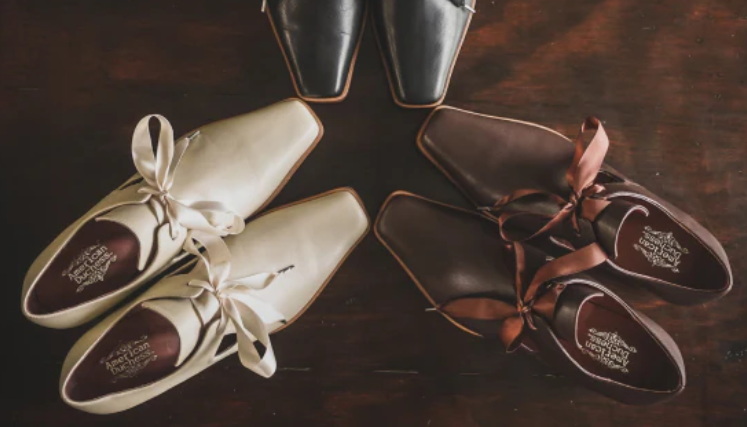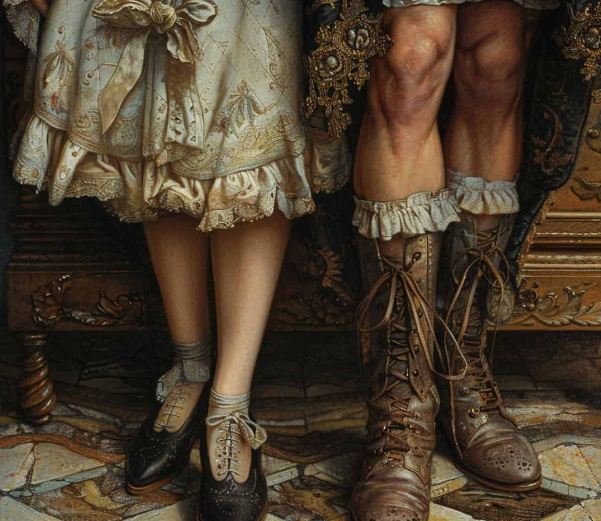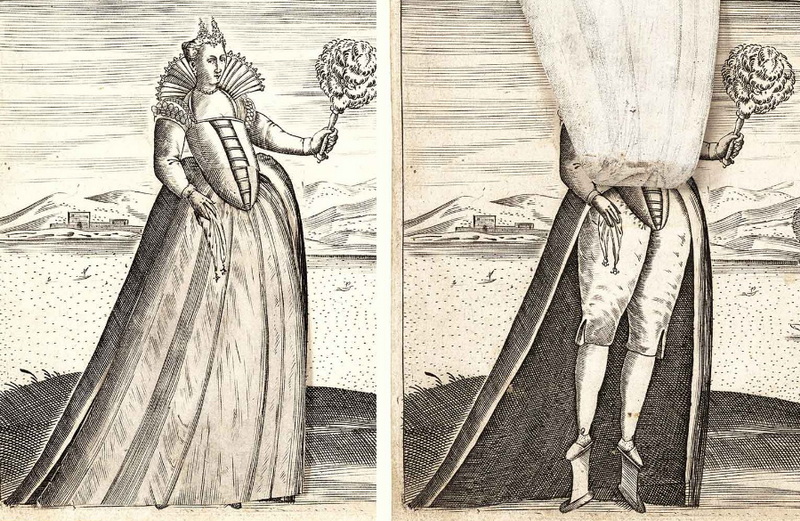Content Menu
● The Evolution of Renaissance Footwear
>> From Practical to Decorative
>> Materials and Craftsmanship
● Popular Styles of Renaissance Women's Shoes
>> 1. Slip-on Shoes
>> 2. Chopines
>> 3. Poulaines
>> 4. Pantofles
>> 5. Pianellas
● Social Significance of Renaissance Footwear
>> Status Symbol
>> Sumptuary Laws
● Materials and Construction
● Regional Variations
>> Venetian Chopines
>> Spanish Influence
● The Legacy of Renaissance Footwear
● Conclusion
● FAQ
>> 1. What materials were commonly used in Renaissance women's shoes?
>> 2. How did social status affect women's footwear choices in the Renaissance?
>> 3. What were chopines and why were they popular?
>> 4. How did Renaissance women's shoes differ from men's?
>> 5. How have Renaissance shoe styles influenced modern footwear?
● Citations:
The Renaissance period, spanning from the 14th to the 17th century, was a time of great cultural and artistic revival in Europe. This era of rebirth and innovation extended to all aspects of life, including fashion and footwear. Women's shoes during the Renaissance were not merely functional items but also served as status symbols and expressions of personal style. Let's embark on a fascinating journey through time to explore the diverse and intricate world of Renaissance women's footwear.

The Evolution of Renaissance Footwear
The Renaissance saw a significant shift in shoe design and construction. As society moved away from the medieval period, footwear began to reflect the changing tastes and values of the time[1].
From Practical to Decorative
Early Renaissance shoes were primarily functional, made of leather and designed for durability. However, as the period progressed, shoes became increasingly decorative, especially for the upper classes[1]. Wealthy women's shoes often featured intricate embroidery, silk fabrics, and even pearls, transforming them into luxurious works of art[2].
Materials and Craftsmanship
The primary material used in Renaissance footwear was leather, which provided durability and flexibility. However, for the wealthy, shoes could be adorned with expensive fabrics like satin or velvet[2]. Skilled cobblers ensured both durability and beauty in every pair, making each shoe a masterpiece[2].
Popular Styles of Renaissance Women's Shoes
Women in the Renaissance had several shoe styles to choose from, each serving different purposes and reflecting various social statuses.
1. Slip-on Shoes
Low-cut, rounded-toe slip-on shoes were common throughout the Renaissance. These shoes were typically made of leather and did not have any fasteners until late in the 16th century[3].
2. Chopines
Perhaps the most iconic Renaissance footwear, chopines were platform shoes that could reach astonishing heights. These elevated shoes, popular in Venice, could be up to 20 inches tall[5]. Chopines served both practical and symbolic purposes - they protected the wearer's dress from street dirt and demonstrated social status.
3. Poulaines
While extreme pointed toes were more common in men's shoes, some women's shoes also featured this style, known as poulaines. However, women's poulaines were generally less exaggerated than men's[7].
4. Pantofles
Pantofles were decorative slip-on shoes often embroidered or adorned with jewels. These were popular choices for showing off status and style at court[5].
5. Pianellas
Pianellas were overshoes worn by ladies in the 15th and 16th centuries when going outdoors. They protected the wearer's shoes and stockings from mud and dirt[8].
Social Significance of Renaissance Footwear
In the Renaissance, as in many eras, footwear was about much more than just protecting one's feet. Shoes were a powerful symbol of social status, wealth, and even occupation[5].
Status Symbol
The type of shoes a woman wore could instantly communicate her place in society. Wealthy women might sport elaborately decorated shoes or towering chopines, while working-class women typically wore simpler, more practical footwear[5].
Sumptuary Laws
Many regions had sumptuary laws that dictated what people could wear based on their social class. These laws often extended to footwear, meaning that certain styles or materials were reserved for the upper classes[5].
Materials and Construction
Renaissance shoemakers were true artisans, crafting footwear from a variety of materials:
1. Leather: The most common material, used for everything from simple work shoes to elaborate court footwear[5].
2. Luxurious Fabrics: Velvet and silk were often used for upper-class women's shoes, especially for indoor wear[5].
3. Wood: Used primarily for the soles of chopines[5].
The craftsmanship involved in creating these shoes was truly impressive. Shoemakers would often collaborate with other artisans like embroiderers and jewelers to create stunning, one-of-a-kind pieces[5].

Regional Variations
While general trends in Renaissance footwear were widespread, there were also notable regional differences:
Venetian Chopines
Venice was particularly known for its extreme chopines. These towering platforms were a symbol of status and wealth, with heights sometimes reaching up to 20 inches[5].
Spanish Influence
Spanish fashion had a significant impact on European styles, including footwear. The popularity of Spanish silk stockings, for instance, influenced shoe design to show off these luxurious items[4].
The Legacy of Renaissance Footwear
The influence of Renaissance footwear can still be seen in modern fashion. Many contemporary designers draw inspiration from these historical styles, creating shoes that blend Renaissance aesthetics with modern sensibilities[5].
Conclusion
The shoes worn by women in the Renaissance were as diverse and fascinating as the era itself. From practical leather slip-ons to towering chopines, these shoes reflected the social, economic, and cultural dynamics of the time. They served not only as protection for the feet but as powerful symbols of status and style.
The craftsmanship and artistry that went into creating Renaissance footwear continue to inspire and amaze us today. As we've seen, these shoes were much more than mere accessories - they were intricate works of art that tell us a great deal about the women who wore them and the society in which they lived.
By understanding the footwear of the Renaissance, we gain valuable insights into the fashion, technology, and social structures of this pivotal period in history. It's a reminder that even the most everyday items can be windows into the past, revealing the rich tapestry of human culture and creativity.

FAQ
1. What materials were commonly used in Renaissance women's shoes?
Leather was the most common material for Renaissance women's shoes, used for both practical and decorative footwear. For wealthy women, luxurious fabrics like silk and velvet were also used, especially for indoor shoes. Wood was primarily used for the soles of chopines, the iconic platform shoes of the era.
2. How did social status affect women's footwear choices in the Renaissance?
Social status played a significant role in Renaissance footwear. Wealthy women wore elaborately decorated shoes made from expensive materials, while working-class women typically had simpler, more practical footwear. Sumptuary laws in many regions even dictated what types of shoes people could wear based on their social class.
3. What were chopines and why were they popular?
Chopines were extremely high platform shoes popular in Venice during the Renaissance. They could reach heights of up to 20 inches and served both practical and symbolic purposes. Practically, they protected the wearer's dress from street dirt. Symbolically, they demonstrated the wearer's wealth and status, as women wearing such tall shoes often required assistance to walk.
4. How did Renaissance women's shoes differ from men's?
While there were similarities, Renaissance women's shoes generally had less extreme styles compared to men's. For example, while men's poulaines (pointed-toe shoes) could be extremely long, women's versions were more modest. Women's shoes were also often hidden under long gowns, making their design sometimes more focused on comfort than outward appearance.
5. How have Renaissance shoe styles influenced modern footwear?
Many modern designers draw inspiration from Renaissance footwear. Elements like decorative embroidery, the use of luxurious fabrics, and even platform soles can be traced back to Renaissance styles. Some designers create shoes that directly reference Renaissance aesthetics, while others incorporate more subtle influences into contemporary designs.
Citations:
[1] https://paoloshoes.com/blogs/timeless-craft/a-journey-into-the-history-of-womens-shoes
[2] https://timelessfashionhub.com/fashion-history/renaissance/renaissance-footwear-styles/
[3] https://www.lovetoknow.com/life/style/renaissance-footwear
[4] https://www.youtube.com/watch?v=afdJqEYnWcw
[5] https://holyclothing.com/blogs/news/womens-footwear-during-renaissance
[6] https://www.outfit4events.com/eur/articles/historical-costumes-and-footwear/historical-shoes/
[7] https://www.deluxeadultcostumes.com/medieval-renaissance-shoes-boots/
[8] https://www.youtube.com/watch?v=4-oVSW1O7gI
[9] https://www.shoezone.com/Womens/Shoes/History-Of-Womens-Shoes

















